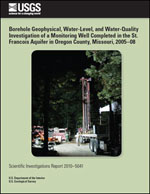A deep (more than 2,000 feet) monitoring well was installed in an area being explored for lead and zinc deposits within the Mark Twain National Forest in southern Missouri. The area is a mature karst terrain where rocks of the Ozark aquifer, a primary source of water for private and public supplies and major springs in the nearby Eleven Point National Wild and Scenic River and the Ozark National Scenic Riverways, are exposed at the surface. The potential lead deposits lie about 2,000 feet below the surface within a deeper aquifer, called the St. Francois aquifer. The two aquifers are separated by the St. Francois confining unit. The monitoring well was installed as part of a series of investigations to examine potentiometric head relations and water-quality differences between the two aquifers.
Results of borehole flowmeter measurements in the open borehole and water-level measurements from the completed monitoring well USGS-D1 indicate that a seasonal upward gradient exists between the St. Francois aquifer and the overlying Ozark aquifer from about September through February. The upward potentiometric heads across the St. Francois confining unit that separates the two aquifers averaged 13.40 feet. Large reversals in this upward gradient occurred during the late winter through summer (about February through August) when water levels in the Ozark aquifer were as much as 138.47 feet higher (average of 53.84 feet) than water levels in the St. Francois aquifer. Most of the fluctuation of potentiometric gradient is caused by precipitation and rapid recharge that cause large and rapid increases in water levels in the Ozark aquifer.
Analysis of water-quality samples collected from the St. Francois aquifer interval of the monitoring well indicated a sodium-chloride type water containing dissolved-solids concentrations as large as 1,300 milligrams per liter and large concentrations of sodium, chloride, sulfate, boron, and lithium. In contrast, water in the overlying Ozark aquifer interval of the monitoring well was a calcium-magnesium-bicarbonate type water containing less than 250 milligrams per liter dissolved solids and substantially smaller concentrations of major and trace elements.


